Five summers ago, I first discovered the wonders of the Wood Wide Web. During our creative design period for Glastonbury Festival a colleague shared ‘From Tree to Shining Tree’, a Radiolab podcast which told the story of mycorrhizal networks: the connections between trees through underground fungal networks.
This was a fascinating story of collaborative biodiversity and symbiosis. It’s a story that would flit through my mind over the course of the next three years.
As an immersive lighting designer, I am often inspired to bring my passion to projects that communicate issues I care deeply about. I’ve used light and sound to encourage collaboration between humans and to campaign for the protection of nature.

As a member of the design team for Greenpeace at Glastonbury I’ve used lighting and creative technologies to involve audiences in important stories about human interaction with nature and was keen to develop these ideas and technologies further. A festival, however, isn’t a great environment to develop new technology. Water and electronics don’t tend to mix well. I needed a little time and space to develop these ideas and technologies further and to focus on them in the level of detail I would have liked.
Fast forward to 2020. With shows and festivals cancelled and the whole world staying at home, I finally had the time to think, play and dream. I wanted to experiment with the tools I have as a lighting designer to take people on a journey - and also give them the freedom to explore and discover an adventure of their own.
I got chatting with artist Poppy Flint, who asked me to help illuminate some tree roots for an exhibition. In this installation, participants would enter into an underground world - roots stretching out above their heads.
Poppy had a strong vision of leading people into a space that would move at a different pace to humans. She wanted to create an experience that would produce a sense of awe at the natural world, and simultaneously a sense of unease with our consumptive human relationship with the environment.
The story of the Wood Wide Web and mycorrhizal networks seemed like a perfect vehicle for the creative uses of technology I had been dreaming up. Could this be an opportunity to put some of my ideas into action? Poppy was game!
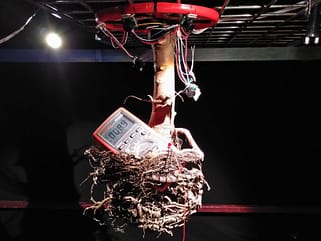
At the time, I had been playing with proximity sensors and contemplating how people interact with light and objects that are illuminated. In nature, plants communicate with each other and react to the proximity of friends or predators. How might we express these communications and reactions with light?
We felt that the mere existence of another life form - this time a human - in the underground domain would cause the roots to respond. I mocked up a root, sensor and light so it would get brighter as people approached it. We could expand on this first step and trigger other events such as sounds and atmospherics based on how close people came to the root.
Trials with individual sensors worked to some extent, but it was difficult to capture people’s movement over a large area. I had been using infrared (IR) motion sensors from above to achieve track movement, but within this low, ‘underground’ installation, there wouldn’t be enough space to capture reliable data. My colleague, Dan, suggested a different approach. We could plot a map and trace a person’s movement using two cameras
A bit of trigonometry and some coding, and voila! We could pinpoint the precise location of people in our installation, and their proximity to the roots and mycelium therein. This gave us the opportunity to develop a story that responded to people’s exploratory movements.
The human could now be the protagonist of the entire piece.
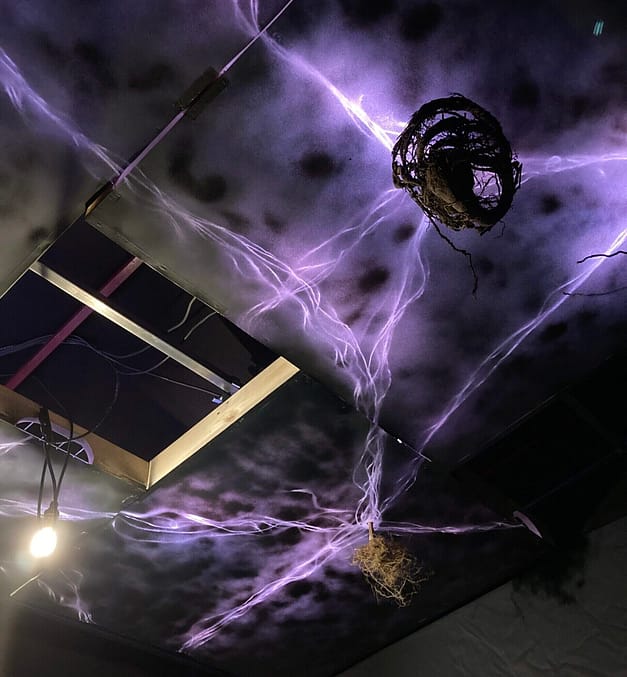
Plants help each other thrive by sharing nutrients. They can warn each other of threats such as insect predators. The mycelium of mycorrhizal fungi (the webs of fungi underground) pass on these messages and compounds, weaving their tendrils within, between and around plants and exchanging nutrients for their own survival and growth.
In our installation, I wanted to represent mycelium and the sharing of nutrients and signals with light. I’ve always struggled with the idea of light for light’s sake. I like light to enhance settings, sculptures or objects, not dominate them.
By representing these signals, light became an integral part of the narrative, rather than a separate element used to enhance the space.
Illuminating the intricate beauty of the roots themselves was also an important part of the installation. By playing with depth and shadow I could make the hairs of the plant glisten and the hairs of the audience stand on end.
Sound would also be an integral part of this underground journey. We worked with friend and sound designer, Lex Kosanke, who was keen to get involved. Lex helped us make sound a fundamental element of the narrative by giving each root a unique sound identity.
The result was ‘Underfoot’ (formerly ‘woven // dissonance’), an interactive audio-visual journey beneath the forest where participants create their own journey to explore their connection to nature.
Here in 2022 it still feels like I am part way through this underground adventure. We still have so much to learn and share, more stories to tell and people to inspire. I don’t yet know how this project will develop, but being able to encourage others to learn about and celebrate biodiversity and symbiosis drives me forward. I hope that we can build on our installation to create a fully interactive audio-visual experience that inspires many more people to respect and treasure our natural world.
You can watch a video made of the installation below.
Escape games can be so much more than a series of brain tickling puzzles. They can be woven into theatrical adventures or museum settings. At their best, they include multidimensional challenges that are part of a complex and gripping adventure.
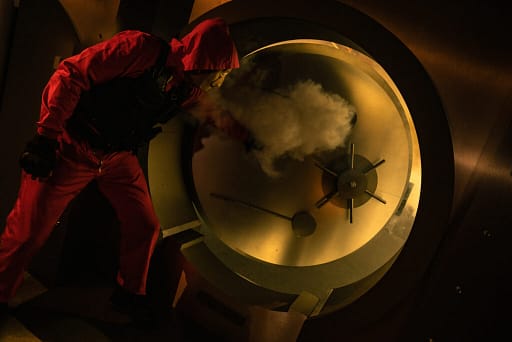
OSCHII helps us integrate escape games into larger theatrical, immersive and museum experiences by creating a network that connects all kinds of things: from lights and sounds to sensors, buttons and game controllers. As participants move through their adventure, their actions, movements and reactions can trigger various components of the games and experience.
In our work designing games for Money Heist: The Experience, we incorporated game elements into a theatrical adventure to create an immersive experience that interfaces with actors and participants in real time as they search for a secret vault of gold in Christie’s auction house. Interactive buttons allow performers and stage managers to queue aspects of the story and enhance the journey.
In the Magna Carta Murders escape room at Westgate Towers, we transformed an existing museum environment into an immersive game-space by turning life-sized statues into game pieces. As players identify statues in the correct order they illuminate, eventually releasing a secret code.
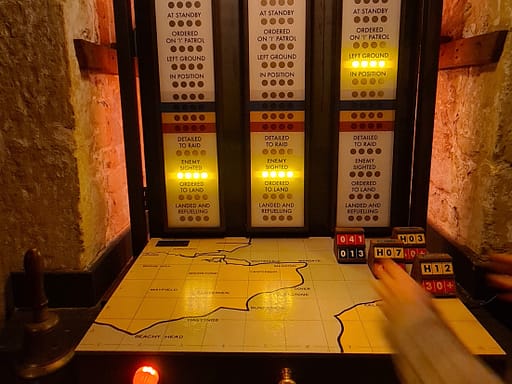
For multidisciplinary games with many components, OSCHII allows us to orchestrate all elements of the game play from a central place. In The Comms Room escape experience, we devised a multifaceted game that included vintage telephones that gave clues players can use to place a prop on the correct place on a map. Once all the pieces are in the correct place, a drawer pops open, giving the key to the next game. OSCHII’s networking capabilities allowed us to control every aspect of the adventure from one place.
Can a group of tech novices make creative games that bridge the digital and physical worlds?
This May, a group of artists and creatives came to Bailes + Light for our first OSCHII Labs. How would they use this interactive digital technology?
Watch to find out!
Bailes + Light social media guru Alexis H. Truax reports on our first attempt at OSCHII labs.
Over a stormy weekend in May, a group of creatives and artists came together at the Bailes + Light studios on the beautiful Aldborough Hall Farm in Ilford, London.
We were a diverse lot: artists, educators, makers, writers, and even a magician! The peacocks in the courtyard paced and screeched as the sky heaved between bright sunshine and torrential downpour. In the studio, our little group sat in hushed anticipation.
As the sun peeked out from behind threatening clouds and the friendly farm cat weaved between our legs, Eva, our fearless facilitator (and Bailes + Light creative project lead), began to explain our mission.
OSCHII is able to read inputs: movement toward a sensor, a finger on a button, a sound, or a Tweet - and turn it into an output - switching on a light, turning a motor, playing back a recording or flashing a request for a cup of tea across a monitor.

This weekend we would learn how to use OSCHII, we would play with some of its many features and we would work together to create interactive games that could support children’s artistic talent and creativity. This would inform our own creative work, let us explore what is possible with OSCHII technology and help steer OSCHII’s continued development.
As we began our first task, the work stations were littered with curious bits of tech: motion sensors and tranceiveres, toggle switches and gears.
So what could we do with this kit? Would the ink kill the OSCHII box, would the sand jam the motors, would a ball bearing fly off and take someone’s eye out? Read on to find out….
It was time to get a hands-on feel for the technology and everyone had a slightly different approach. One group went for fun and functional, using a beam breaker to play a recording reminding everyone to mask up as they entered the threshold of the workshop. Another designed a light that would shine brighter the closer a person moved toward it. Yet another took a games approach to the task by programming a series of colored buttons that, when pushed in combination, would illuminate LEDs: red and yellow for orange light, green and yellow for blue.
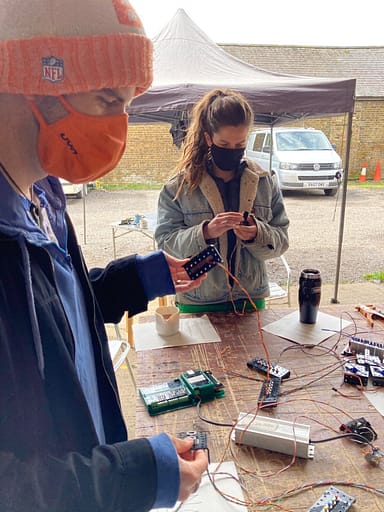
Eva had given us a mysterious and intriguing instruction for the weekend: bring 3 fun objects. As we each brought out our stash, the table was stacked high with an assortment of random and playful objects: pipe cleaners and sand, ink and kaleidoscopes, toothpaste and noisemakers of several varieties.
Looking at our table of supplies, both groups quickly decided that the most promising objects were traditional art supplies and musical instruments. We could combine them with digital and mechanical devices in new and unforeseen ways: Melding traditional tools of creativity with new technology to create surprising forms of expression & novel experiences.
Team Octopus decided to build a game that would allow participants to create art collaboratively. It would use traditional art supplies like ink & charcoal but require players to work together to figure out how to use sensors and buttons to move them across the page.
Team Cicada would design a treasure hunt that would let participants explore their surroundings to reveal answers that would play a tune and illuminate a series of coloured lights.
We got to work. The studio was abuzz with drilling and sawing, the whirring of motors, the plinking of a xylophone and excited chatter. With a whole workshop of materials and the incredible skill and knowledge of the B+L team, our games slowly came together. By the end of the day we were ready to share our new creations.
The treasure hunt began with participants scanning a code to receive a map on their phones. By following the map and a series of clues we wandered all over the farm to find tiny mallets hidden around the property. When we placed the mallets correctly into a tube, it would spin to play a recognisable tune on the xylophone. Contact sensors under the keys set off a series of colored lights in a specific order.
The collaborative drawing game had three players at different stations who had to work together to create a piece of art through sound and movement. One player controlled the rotation of the paper by moving his hand closer and farther away from a proximity sensor. Another controlled the movement of the pen with the volume of her voice. The third controlled the movement of the pencil by pressing a series of buttons. The catch? Each player’s station could only be activated by a player across the table. There was much amusing waving of hands, singing and pressing of buttons as the players learned how to work together to guide the pen and pencil across the page. The results were impressive and now adorn the studio fridge!
The OSCHII creative lab with Bailes + Light was a joyful weekend of creative learning through play and experimentation. We combined traditional and technological forms of expression to create games that opened up new ideas for collaboration and discovery.



OSCHII was born out of frustration and passion. For several years we produced theatrical and immersive interactive games with patched together technologies that were time consuming, complex and didn’t always live up to our creative vision. We decided it was time to turn our hard-won lessons into a new, easy to use and integrated platform. OSCHII would let us create and help others create.
We began building Escape Rooms a few years ago using off the shelf tech, mostly designed for ‘fright’ experiences such as haunted houses.
In many ways they were great--designed to be installed by people with limited experience and knowledge of immersive technology. We love the idea of making this kind of tech accessible to a wide range of creators.
But the more we worked with them, the more time consuming, complicated and expensive using this so-called simple to use, “DIY” technology became. As the games developed, the circuitry got more complicated and, unfortunately, messier. We spent long hours up to our eyebrows in wires and circuit boards hacking everything together. In the end, it just wasn't powerful enough, it didn't quite do what we wanted it to do, and the many hundreds of additional hours spent making circuits that allowed us to do what we wanted to do was, well, getting silly and unaffordable.
It’s fair to say that our escape rooms are fairly technologically complex.
The game technology that we use needs to network with all sorts of other things: atmospheric lighting and audio, billowing smoke, and props such as vintage telephones or swinging lights.
Because we specialise in immersive theatre, we know how to use the whole environment to affect emotion and enhance the journey of the participants. The game technology that we use needs to network with all sorts of other things: atmospheric lighting and audio, billowing smoke, and props such as vintage telephones or swinging lights. As participants move through this adventure, we also need to be able to lock and unlock game elements as one challenge ends and another begins.
We experimented with slightly different technology for our second escape room, bringing it closer to the comfort of our work in immersive theatre and allowing us to inject more drama into the experience.
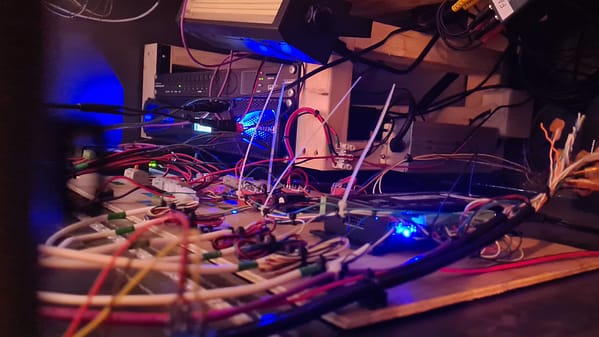
Sound, light, and atmospherics were all carefully scripted and programmed into a complete timeline. In our theatrical productions, we use software that automates many functions within a show to create a slick, fully immersive experience that injects suspense and can leave people with goosebumps.
Yet we still faced the same difficulties integrating this software with the off-the-shelf games hardware. We really needed a technology that was built with all of this in mind.
Outside of work with escape rooms, we encountered similar problems.
We’ve made several large-scale interactive games for festivals, such as a challenge in which around 50 participants joining hands trigger a light show that demonstrates how working together can initiate change. Another game is the terrifying immersive adventure in which the participant becomes a fish caught by a super trawler.
Each time we create these experiences we spend more time working on the technology than focusing on improving the actual game experience itself. We wanted to make more time for creativity and artistry.
Escape Rooms, immersive theatre, interactive off-line gaming and sensory artworks all have many things in common - they are highly engaging, interactive, immersive, playable and fun activities that are part of a wider family of experiences. Their creation is also often sadly hindered by a lack of technical knowledge. Whilst creating OSCHII, we wanted to use our experiences in these creative industries to make a technology that can be shared with others. We wanted to reduce the steepness of that learning curve and the headaches that came with hacked together webs of technology. We wanted to be able to create, and allow others to create.
It was time to make life easier for us and cheaper for our clients. It was time to help other creators focus on artistry instead of technology. It was time for a new, better, DIY immersive technology.
Then came the pandemic. We had time! We bring you OSCHII.
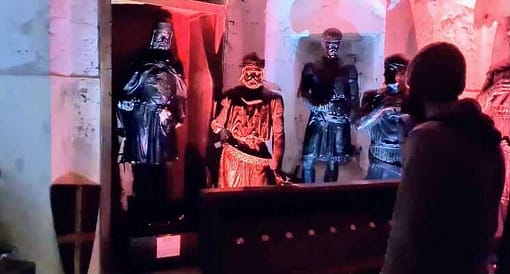
At the heart of art and creativity lies the need to communicate. ‘Only connect’ in EM Forster’s words. OSCHII gives artists new ways to talk to their audiences, and gives audiences new ways to talk back to art--by becoming participants. This new technology works with spatial interplay, giving artists a choice of tools to tangibly connect with audiences.
As artists and designers ourselves, we understand that technology is both inspirational and extremely frustrating.
On the one hand, learning something new opens pathways, provides inspiration for new projects and can send us down a rabbit hole of novel ideas and adventures. On the flip side, sometimes we just want to do something that *should* be fairly simple on paper but is actually a bloody nightmare when you start trying to work out the details. It becomes a barrier to innovation and creativity, and the whole project can quickly end up on the cutting room floor of creative inspiration.
So how can you use technology to make your art more interactive?
Maybe you’d like to tell someone a story or share some inspiration as they freely move through a space - a journey tailored to objects that they pass, the direction they are headed in, or what they leave behind? Or perhaps you’ve made a game based on retrieving an object that you’d like to find a way to capture digitally?
There are many things you might want to consider when deciding how to go about this, such as from whose perspective you might record the tracking data - the subject, or the object, or all data in an open space. This will decide what devices you have available to use - from cameras to ultrasonic or IR sensors, pressure or RFID tags.
What if you were to use real time sensor data to form part of an artwork that allowed for mass participation from people both locally and globally?
We’re not here to lecture you on how to go about creating your installation, nor do we have all the answers for you. But, we do have a tool that will make using technology to connect the artist and audience easier.
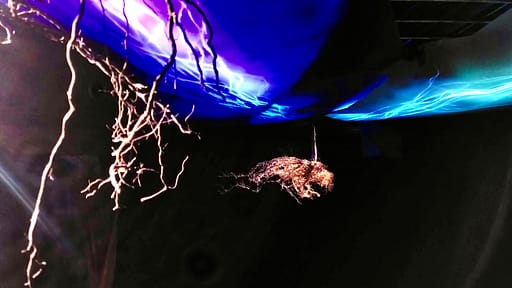
OSCHII helps you to process data from a number of different inputs by providing you with a ‘layer of abstraction’ so you don’t have to go away and learn everything. It can process signals from audio patterns, proximity sensors and conductive items to QR codes and hashtags on social media. It can even allow for participation from people around the world through integrations from all over the web.
It’s still up to you how you wish to process this data and create your interactive narrative.
We’re currently developing a workshop that will invite artists and other creatives into our studio to play with some of these sensing devices and processors. This will give them the space to develop ideas, narratives and experiences inspired by their own professions and disciplines. We stand by the principles of open source and many of the developments we make are shared with others with the common goal of culture. We are all artists.
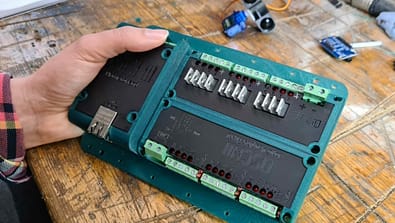
We’re excited to introduce OSCHII, our homegrown technology that allows audiences to interact with artworks and their environments - which in turn are able to respond to the audience. OSCHII makes it possible for artists, designers, performers and games makers - pretty much anyone - to use technology to make their ideas truly interactive.
Let’s be honest, not all creators are also passionate about learning to code or the intricacies of computer programming. OSCHII makes the process of integrating interactive technology into artistic projects easier, faster and more affordable. Rather than spending time and energy learning complicated systems, creators can focus on doing what they love - be it designing a soundscape in real time, telling a story that inspires and responds to a person’s movement through a space, or bringing vintage technologies back to life for new purposes.
OSCHII has a wide variety of applications including escape rooms, immersive theatre, and interactive art and museum exhibitions. With a wave of the hand, a participant might set off a sudden blaze of light, play the first few notes of a symphony, decode secret war time communications or unlock the door to another realm. OSCHII can also collect signals and data from the physical and virtual world, such as the location of an artefact; the concentration of air pollutants by a school, the most appreciated tree on a marsh, or the number of times a hashtag has been used.
OSCHII is designed to make device to device and person to person communication easier. It helps simplify connectivity by eliminating the steep learning curves associated with other processors like Arduino and Raspberry Pi. Instead, it allows users to learn the basics, and then use graphics-driven computer programs to manipulate the data they are collecting or sharing. The hardware itself provides the building blocks that can be expanded on as your project evolves.
So, what is OSCHII? OSCHII believes that technology should help rather than hinder creativity. It allows a wide range of creators to make works that respond to participants in real time and helps artists and audiences to connect and create. At its core OSCHII believes everyone is an artist.